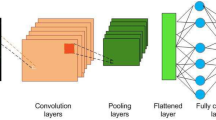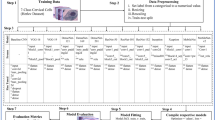Abstract
Skin cancer is one of the most deadly diseases around the world, wherein one of the three cancers is skin cancer. Early detection of skin cancer is paramount for better treatment planning. This paper investigates a Convolutional Neural Network (CNN), specifically, You Only Look Once (YOLO), to extract features from the skin lesions. The features, obtained from the CNN, are concatenated with traditional features like texture and colour features extracted from the lesion region of the input images. Later, the concatenated features are fed to a Fully Connected Network, which is trained with the specific ground truths to achieve higher classification accuracy. The proposed method improves the detection and classification of skin lesions when compared with other models and YOLO without traditional features. The performance measures of the fusion network are able to achieve the accuracy of 94%, precision of 0.85, recall of 0.88, and area under the curve of 0.95.








Similar content being viewed by others
References
Baldwin, L.; Dunn, J.: Global controversies and advances in skin cancer. Asian Pac. J. Cancer Prev. 14(4), 2155–2157 (2013)
Pfeifer, G.P.; Besaratinia, A.: UV wavelength-dependent DNA damage and human non-melanoma and melanoma skin cancer. Photochem. Photobiol. Sci. 11(1), 90–97 (2012)
Craythorne, E.; Al-Niami, F.: Skin cancer. Medicine 45(7), 431–434 (2017)
Tracey, E.H.; Vij, A.: Updates in melanoma. Dermatol. Clin. 37(1), 73–82 (2019)
Jerant, A.F.; Johnson, J.T.; Sheridan, C.D.; Caffrey, T.J.: Early detection and treatment of skin cancer. Am. Fam. Phys. 62(2), 357–368 (2000)
Sreelatha, T.; Subramanyam, M.V.; Prasad, M.N.G.: Early detection of skin cancer using melanoma segmentation technique. J. Med. Syst. 43(7), 190 (2019)
Massone, C.; Di Stefani, A.; Soyer, H.P.: Dermoscopy for skin cancer detection. Curr. Opin. Oncol. 17(2), 147–153 (2005)
Wolner, Z.J.; Yélamos, O.; Liopyris, K.; Rogers, T.; Marchetti, M.A.; Marghoob, A.A.: Enhancing skin cancer diagnosis with dermoscopy. Dermatol. Clin. 35(4), 417–437 (2017)
Jain, S.; Pise, N.; et al.: Computer aided melanoma skin cancer detection using image processing. Procedia Comput. Sci. 48, 735–740 (2015)
Barata, C.; Ruela, M.; Francisco, M.; Mendonça, T.; Marques, J.S.: Two systems for the detection of melanomas in dermoscopy images using texture and color features. IEEE Syst. J. 8(3), 965–979 (2013)
Nezhadian, F.K.; Rashidi, S.: Melanoma skin cancer detection using color and new texture features. In: 2017 Artificial Intelligence and Signal Processing Conference (AISP), pp 1–5. IEEE (2017)
Ashour, A.S.; Hawas, A.R.; Guo, Y.; Wahba, M.A.: A novel optimized neutrosophic k-means using genetic algorithm for skin lesion detection in dermoscopy images. Signal Image Video Process. 12(7), 1311–1318 (2018)
Abuzaghleh, O.; Barkana, B.D.; Faezipour, M.: Noninvasive real-time automated skin lesion analysis system for melanoma early detection and prevention. IEEE J. Transl. Eng. Health Med. 2015, 1–12 (2015)
Mhaske, H.R.; Phalke, D.A.: Melanoma skin cancer detection and classification based on supervised and unsupervised learning. In: 2013 International conference on Circuits, Controls and Communications (CCUBE), pp. 1–5. IEEE (2013)
Alquran, H.; Qasmieh, I.A.; Alqudah, A.M.; Alhammouri, S.; Alawneh, E.; Abughazaleh, A.; Hasayen, F.: The melanoma skin cancer detection and classification using support vector machine. In: 2017 IEEE Jordan Conference on Applied Electrical Engineering and Computing Technologies (AEECT), pp 1–5. IEEE (2017)
Saez, A.; Sanchez-Monedero, J.; Gutiérrez, P.A.; Hervás-Martínez, C.: Machine learning methods for binary and multiclass classification of melanoma thickness from dermoscopic images. IEEE Trans. Med. Imaging 35(4), 1036–1045 (2015)
Esteva, A.; Kuprel, B.; Novoa, R.A.; Ko, J.; Swetter, S.M.; Blau, H.M.; Thrun, S.: Dermatologist-level classification of skin cancer with deep neural networks. Nature 542(7639), 115–118 (2017)
Pham, T.-C.; Luong, C.-M.; Visani, M.; Hoang, V.-D.: Deep CNN and data augmentation for skin lesion classification. In: Asian Conference on Intelligent Information and Database Systems, pp. 573–582. Springer (2018).
DeVries,T.; Ramachandram, D.: Skin lesion classification using deep multi-scale convolutional neural networks. arXiv:1703.01402 (2017)
Peng, X.; Saenko, K.: Combining texture and shape cues for object recognition with minimal supervision. In: Asian Conference on Computer Vision, pp. 256–272. Springer (2016)
Saba, T.; Khan, M.A.; Rehman, A.; Marie-Sainte, S.L.: Region extraction and classification of skin cancer: a heterogeneous framework of deep CNN features fusion and reduction. J. Med. Syst. 43(9), 289 (2019)
Rashid, M.; Khan, M.A.; Sharif, M.; Raza, M.; Sarfraz, M.M.; Afza, F.: Object detection and classification: a joint selection and fusion strategy of deep convolutional neural network and sift point features. Multimed. Tools Appl. 78(12), 15751–15777 (2019)
Serte, S.; Demirel, H.: Gabor wavelet-based deep learning for skin lesion classification. Comput. Biol. Med. 113, 103423 (2019)
Sorokin, A.: Lesion analysis and diagnosis with mask-rcnn. arXiv:1807.05979 (2018)
Taqi, A.M.; Al-Azzo, F.; Awad, A.; Milanova, M.: Skin lesion detection by android camera based on SSD-mobilenet and tensorflow object detection API. Am. J. Adv. Res. 1, 3 (2019)
Roy, S.S.; Haque, A.U.; Neubert, J.: Automatic diagnosis of melanoma from dermoscopic image using real-time object detection. In: 2018 52nd annual conference on information sciences and systems (CISS), pp. 1–5. IEEE (2018)
Redmon, J.; Divvala, S.; Girshick, R.; Farhadi, A.: You only look once: Unified, real-time object detection. In: Proceedings of the IEEE Conference on Computer Vision and Pattern Recognition, pp. 779–788 (2016)
Situ, N.; Yuan, X.; Chen, J.; Zouridakis, G.: Malignant melanoma detection by bag-of-features classification. In: 2008 30th Annual International Conference of the IEEE Engineering in Medicine and Biology Society, pp. 3110–3113. IEEE (2008)
Barata, C.; Celebi, M.E.; Marques, J.S.J.S.: A survey of feature extraction in dermoscopy image analysis of skin cancer. IEEE J. Biomed. Health Inform. 23(3), 1096–1109 (2018)
Sivic, J.; Zisserman, A.: Video google: a text retrieval approach to object matching in videos. In: Null, p. 1470. IEEE (2003)
Sultana, N.N.; Puhan, N.B.: Recent deep learning methods for melanoma detection: a review. In: International Conference on Mathematics and Computing, pp. 118–132. Springer (2018)
Kavitha, J.C.; Suruliandi, A.: Texture and color feature extraction for classification of melanoma using SVM. In: 2016 International Conference on Computing Technologies and Intelligent Data Engineering (ICCTIDE’16), pp. 1–6. IEEE (2016)
Sotoodeh, M.; Moosavi, M.R.; Boostani, R.: A novel adaptive lbp-based descriptor for color image retrieval. Expert Syst. Appl. 127, 342–352 (2019)
Zhu, C.; Bichot, C.-E.; Chen, L.: Multi-scale color local binary patterns for visual object classes recognition. In: 2010 20th International Conference on Pattern Recognition, pp. 3065–3068. IEEE (2010).
Singh, G.; Chhabra, I.: Effective and fast face recognition system using complementary OC-LBP and HOG feature descriptors with SVM classifier. J. Inf. Technol. Res. (JITR) 11(1), 91–110 (2018)
Li, J.; Sang, N.; Gao, C.: Completed local similarity pattern for color image recognition. Neurocomputing 182, 111–117 (2016)
Benco, M.; Hudec, R.; Kamencay, P.; Zachariasova, M.; Matuska, S.: An advanced approach to extraction of colour texture features based on GLCM. Int. J. Adv. Robot. Syst. 11(7), 104 (2014)
Deng, J.; Dong, W.; Socher, R.; Li, L.-J.; Li, K.; Fei-Fei, L.: Imagenet: a large-scale hierarchical image database. In: 2009 IEEE Conference on Computer Vision and Pattern Recognition, pp. 248–255. IEEE (2009)
Lin, T.-Y.; Maire, M.; Belongie, S.; Hays, J.; Perona, P.; Ramanan, D.; Dollár, P.; Zitnick, C.L.: Microsoft coco: common objects in context. In: European Conference on Computer Vision, pp. 740–755. Springer (2014)
Gutman, D.; Codella, N.C.F.; Celebi, E.; Helba, B.; Marchetti, M.; Mishra, N.; Halpern, A.: Skin lesion analysis toward melanoma detection: a challenge at the international symposium on biomedical imaging (ISBI) 2016, hosted by the international skin imaging collaboration (ISIC). arXiv:1605.01397 (2016)
Acknowledgements
The authors would like to thank Memorial Sloan-Kettering Cancer Center for their contribution in establishing the ISIC Archive. We would also like to thank Gutman et al. [40] for making their database openly available. The authors would like to thank Vellore Institute of Technology, Vellore, for providing the required support to carry out this research work.
Funding
This research was financially supported by the Scientific Research Grant of Shantou University, China, Grant No: NTF17016.
Author information
Authors and Affiliations
Corresponding author
Ethics declarations
Conflict of interest
The authors declare that they have no conflict of interest.
Ethical approval
This article does not contain any studies with animals performed by any of the authors. All procedures performed in studies involving human participants were in accordance with the ethical standards. The dataset used for experimentation is ISBI Melanoma dataset obtained from the 2016 International Skin Imaging Collaboration (ISIC) skin lesion classification challenge. The dataset is publicly available at https://www.isic-archive.com/#!/topWithHeader/onlyHeaderTop/gallery, and many researchers have used these images to experimentally verify and compare their works. As required we have also included the reference [40] which is related to their original publication. Further, we have also recognized their support by thanking them under the acknowledgment section.
Rights and permissions
About this article
Cite this article
Nersisson, R., Iyer, T.J., Joseph Raj, A.N. et al. A Dermoscopic Skin Lesion Classification Technique Using YOLO-CNN and Traditional Feature Model. Arab J Sci Eng 46, 9797–9808 (2021). https://doi.org/10.1007/s13369-021-05571-1
Received:
Accepted:
Published:
Issue Date:
DOI: https://doi.org/10.1007/s13369-021-05571-1




